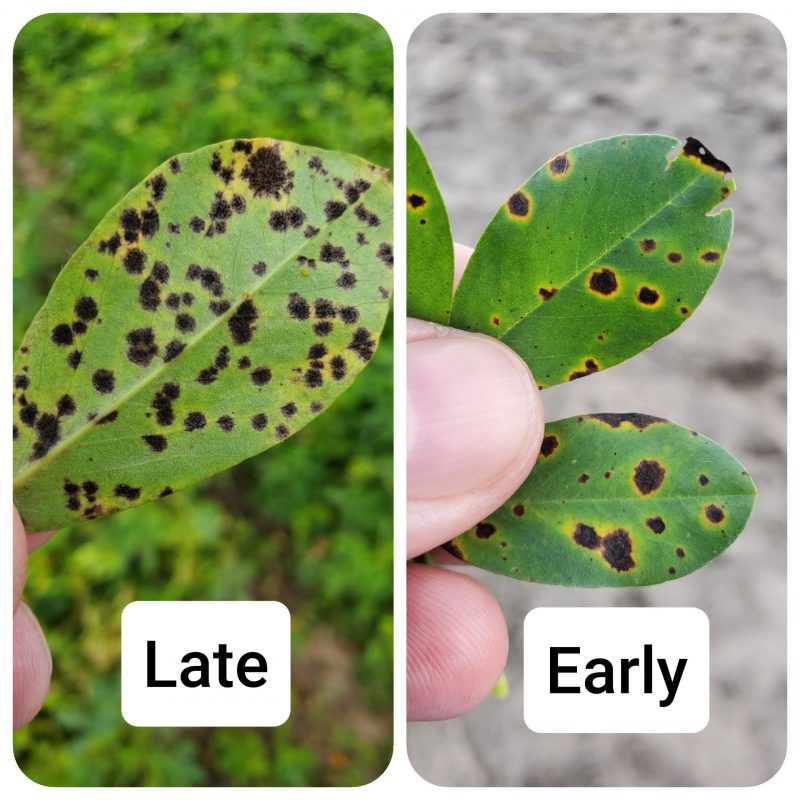Ethan Carter, Daniel Leonard, Mark Warren, Beth Cannon, Jay Capasso, Barry Tillman, Nick Dufault, UF/IFAS Extension Peanut Team
Over the last 7 to 10 days, reports of peanut leaf spot and rust diseases have increased from Levy to Jackson counties. It is important for growers to monitor fields, especially later planted fields around 100 days after planting (DAP), and fields that are not being scouted.
–
Leaf Spots
–
On PeanutRx, varieties with a leaf spot score of 20 are considered susceptible, while a score of 25 or higher indicates high susceptibility (e.g., FloRun T61, Georgia-09B, Georgia-16HO, Georgia-18RU, TUFRunner 297, and TUFRunner 511).
At the Marianna research station, both untreated and well-sprayed plots of these cultivars planted on May 7th (105 DAP) have leaf spot diseases present with ~4 to 5 weeks remaining until harvest. It is expected that rapid defoliation will occur over the next 2-3 weeks, if environmental conditions remain conducive for the pathogens, which may result in early digging of a field. As a field approaches ~50% defoliation, plan to dig within 7 days; waiting until 75% defoliation is reached results in significant pod loss due to vine and peg degradation.
Maintaining a timely and effective fungicide program is key to disease control. Products can range in their effectiveness from one disease to another, and some are most effective when positioned at specific times in the season. When spraying older peanuts (>100 DAP), pre-harvest intervals (PHI) are important factors to consider when selecting a product. Table 1 lists a few fungicides with targeted activity for leaf spots.
| MOA* | Active Ingredient | Product Name | Preharvest Interval (days) | Rate/Ac
(fl oz) |
Target Leaf Spot Type Activity |
| 3 | mefentrifluconazole | Provysol | 14 | 2.5-7 | Late leaf spot |
| 3 | prothioconazole + tebuconazole | Provost Silver | 14 | 11-13 | Early leaf spot |
| 3 +7 | flutriafol + bixafen | Lucento | 14 | 5.5 | Late leaf spot |
| Leaf Spot Mixing Partners** | |||||
| M | chlorothalonil | Bravo, Echo, many generics | 14 | 16 – 24 | Early and late leaf spot |
| M | sulfur (micronized) | Many generics | See Label | 38.4 – 140.8^ | Early and late leaf spot |
Table 1. Always read and follow the label. Examples only; not all-inclusive. This example lists several products that could be positioned later in the season when fields have high leaf spot incidence. *MOA stands for mode of action, meaning the site where a product affects the fungus. **Many leaf spot fungicides vary in their activity against early and late leaf spot. Under high disease risk, it is recommended to include (mix in) a protectant fungicide, especially when using older chemistries with MOA groups 3 and 11. ^Micronized sulfur products are available in both dry (powder) and liquid formulations. Refer to the product label for the exact application rate. For dry formulations, the typical range is 3–5 lbs. per acre.
–
Rust
–
Peanut rust is not uncommon in the eastern part of Florida but does not reach damaging levels in most years. Unfortunately, this year (2025), rust has already been found from the Suwannee Valley to the Panhandle at damaging levels. This is a situation that needs to be monitored closely, since rust can spread very rapidly. (Note: Peanut Rust was confirmed to be in peanuts at the NFREC Marianna on 8/22/25). Most fungicide products with activity against peanut rust have a pre-harvest interval of 14 days (Table 2). However, it is important to note that some have longer intervals (e.g. 30 days). Also, for fields with severe late season peanut rust, digging prior to optimum maturity may be required to avoid significant vine health deterioration. For example, if rust is confirmed and harvest is >30 days away, consider tightening to 7 to 10-day spray intervals; if vine health declines and maturity is close, prioritize digging over chasing infections.
| Mode of Action | Active Ingredient | Product Name | Preharvest Interval (days) | Rate/Ac (fl oz) |
| 11 | azoxystrobin | Abound (many generics) | 14 | 12-24.5 |
| 11 | pyraclostrobin | Headline | 14 | 6-15 |
| 3 | prothioconazole + tebuconazole | Provost Silver | 14 | 11-13 |
| 3 | tebuconazole | TebuStar (many generics) | 14 | 7.2 |
| 3 | tetraconazole | Domark 230ME | 14 | 5.25-6.9 |
| 3 | cyproconazole | Alto | 30 | 5.5 |
| 7 | penthiopyrad | Fontelis | 14 | 24 |
| 7 | inpyrfluxam | Excalia | 40 | 2-4 |
| 7 + 11 | azoxystrobin + benzovindiflupyr | Elatus | 30 | 7.3-9.5 |
Table 2. This is not an all-inclusive list, but it shows several products with effective activity for peanut rust management.
–
For questions or more information, contact the UF/IFAS Extension Peanut Team or your local Extension agent.
- 2025 Peanut Field Day Recap & Speaker Handouts - August 29, 2025
- Peanut Foliar Diseases Exploding Across Florida - August 22, 2025
- Provisional Nitrogen Fertilization Recommendation for Florida Cotton for the 2025 Season - June 20, 2025


